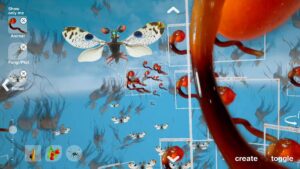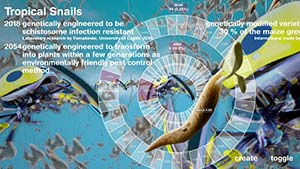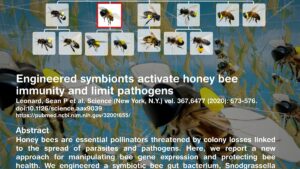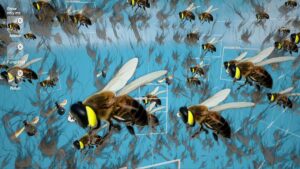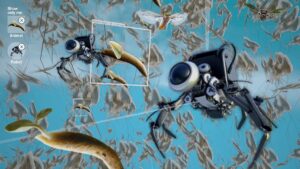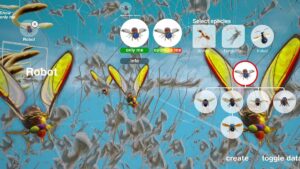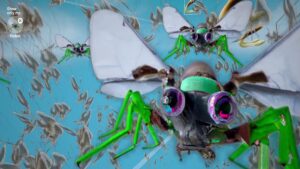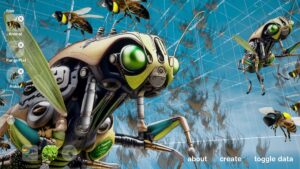Mobile App as Interface for Net-Based Installations
Scientists and farmers are increasingly relying on technologies such as genetic engineering, synthetic biology, and machine learning to address the challenges of species extinction and global warming. Speculative Evolution imagines a speculative ecosystem 30 years from now, where artificial intelligence and biotechnologies work together to create and optimize species to withstand the increasingly hostile environment. From the perspective of an AI simulator, the audience is invited to create new variations of animals, fungi, plants, and robots, fly with these engineered and mutated species, and observe the changing ecosystem. Speculative Evolution responds to the trend of technology-assisted solution-making by constructing narratives of an uncomputable system under extreme control – what do we optimize, and what are we ignoring as a result? The project aims to inspect our tendency to simplify complex ecosystems by treating nature as a system that can be fixed.
Description
This experiment is a speculative simulation of a future ecosystem. The narrative sets in a speculative farm, 30 years from now, where artificial intelligence and synthetic biology work together to create an optimized environment for farmed species. An AI agent helps the audience to generate new species to balance a delicate ecosystem.
Based on scientific publications on synthetic biology, genetic engineering and robotics, we envisioned how species could be further developed to increase their resilience and formulated text prompts to create AI-generated images using DALL-E. As a result, each speculative species in the environment has a backstory rooted in real-life scenarios: bees which lose the sense of orientation due to pesticides; snails that are displaced by invasive species; rice that is exposed to increasing drought and temperature. We imagine a future where technologies like 3D printing, CRISPR, and synthetic biology play a part in modifying species for a higher chance of survival – genetically engineered super-bees with 3D-printed parts that restore their lost navigation skills; Hawaiian land snails with snake DNA to control the introduced snail invasion; genetically modified drought-tolerant and protein-rich rice.
Given the dire projection on global warming and species extinction, humans increasingly look to technology for creative solutions. In Under a White Sky, author Elizabeth Kolbert pointed to “control” as the fundamental false logic of the Anthropocene: “If control is the problem, still more control must be the solution.” As we navigate an increasingly delicate political atmosphere, technosolutionism dominates conversations about climate change.
Artificial intelligence has become the star of the technosolutionist way of thinking with its promises of creative problem-solving packaged in a “black-box technology”. The technology comes with its own human-imposed biases – what do we optimize, and who do we optimize for? When we try to compute an uncomputable system, whose needs do we consider and prioritize? Speculative Evolution looks at some of the technologies we use today and imagined a future where artificial intelligence takes them to an extreme. Machine learning and biotechnologies are currently used to identify, monitor, and map species, as well as create new genetic traits. It’s not hard to imagine a not-so-distant future where machine learning does the balancing act of optimizing for human objectives. We believe that this is not a utopia or a dystopia, but rather a direction in which we are heading.
Research
Speculative Evolution is a further development of the projects CAON and YANTO and was partly developed during a residency at the transmediale studio in Berlin and at a research residency in Pakistan. The research involved visiting institutions that conduct laboratory trials on animal genetic modification, such as the Max Delbrück Centre for Molecular Medicine in Berlin and the LAMS Department of Life Sciences in Lahore.
Audience Experience and Impact
The audience interacts with the installation via smartphone and navigates through a speculative 3D environment. In the exhibition space, the sound is transmitted to a sound system and the mobile display is projected onto one or multiple walls. In this experiment, the audience can use a DALL-E integration to create new animal, fungi, plant and robot variations. Through the perspective of an AI Agent, they can fly with these and the variations of all users who have installed the mobile app. The audience can observe how new creatures might look like when artificial intelligence is used to create and optimize them, and how they impact the ecosystem. They can read the abstracts of the scientific publications on which each speculative creature is based, read a prediction how it is further engendered, and inspect its lineage. The 3D environment is endless and can be navigated in every direction. The sonic sound experiences are composed for this simulation and respond to all movements and navigation modes. We hope to invite the audience to investigate our tendency to simplify complex ecosystems by treating nature as a system that can be calculated and optimized.
Screenshots
Speculative Evolution mobile app download (free)

Award
🏆 Speculative Evolution won the Expanded Media Award for Network Culture at the international competition of the Stuttgarter Filmwinter (2024)

